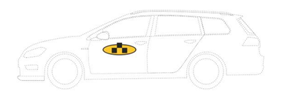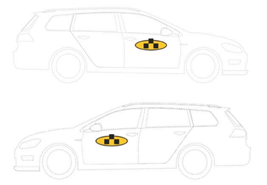We invite you to have a look at the 54th issue of Turvaja newsletter.

Newsletter No. 38
December 2021
Decisions of the Estonian Industrial Property Board of Appeal
I Oppositions
Decision No. 1991-o
Earlier trademark
Baojaam
Opposed trademark

Opposition to registration of the trademark „BAO YAM + device“.
The Board considers that the visual difference between the comparable marks is present only in the middle of the dominant elements and is less pronounced. Aurally, the marks are even more similar in that the letters “J” and “Y” are pronounced identically. For a foreign-speaking consumer, including a tourist who does not know double vowels in Estonian, the marks may not differ phonetically at all. The Board considers that the words “Baojaam” and “BAO YAM” are semantically meaningless to Estonian consumers, so that the comparable signs are also semantically similar.
Although the applicant’s trademark contains the element “ASIAN RESTAURANT” in addition to the element “BAO YAM”, that element appears in a much smaller font and remains in the background; in addition, it refers directly to the characteristics of the services sought and is therefore not distinctive.
The design elements in the applicant’s mark are also not sufficiently memorable and different from the usual on the market to distinguish the applicant’s mark from the opponent’s earlier mark.
As regards the services in Class 43 covered by the applicant’s and the opponent’s marks, the Board considers that all the comparable services fall within the category of catering services, so that they are of the same type and largely identical.
According to the Board, there is a likelihood of confusion between the marks by the consumer, including the association of the applicant’s mark with the opponent’s earlier mark.
The opposition was sustained.
Decision No. 1996-o
Earlier trademark
MOLECULE
Opposed trademark

Opposition to registration of the trademark “M MOLECULE PERFUME SPACE + device“ (accelerated procedure).
The opponent considers that the applicant’s mark “M MOLECULE PERFUME SPACE + device“ is so similar that there is a likelihood of confusion with the opponent’s earlier mark “MOLECULE”. In addition, the applicant’s goods in Class 3 are included in Class 3 of the goods protected by the opponent’s earlier mark.
The Patent Office forwarded the notice of filing of the opposition to the proprietor of the opposed trademark. The owner has not nominated their representative, thus, the Board applies the accelerated procedure. Under these circumstances, the Board will, in the final proceedings, grant the application without giving reasons for its decision, in so far as it is not manifestly unfounded.
The opposition was sustained.
II Cancellations
Decision No. 1873-o
Opposed trademark

Application for the invalidation of the exclusive right of the proprietor of the trademark “vürtsid + device”.
The earlier right which gives the opponent claim for the contested mark is copyright. The opponent has submitted evidence that a sign identical to the contested trademark has been developed for use by the opponent on the basis of a development agreement concluded with the Estonian Academy of Arts (EAA) and has been handed over to the petitioner. According to the annex to the development agreement, ownership rights relating to an eventual trademark were transferred from EAA to the opponent. According to the same annex, the author granted the opponent the exclusive right to apply to the competent authority for the protection of the work, including the registration of the trademark.
Although the Board did not consider the opponent’s use of a sign identical with or similar to the contested mark to be regarded as having acquired well-known character, there is no doubt that the opponent used the sign developed and commissioned by the EAA.
The Board validates the opponent’s opinion that the opponent has not given permission to register the contested trademark in accordance with the procedure prescribed by law.
In the light of the above, the Board considers that the application for registration of the contested mark by the applicants was done in bad faith and therefore constitutes a ground for revoking the exclusive right of the contested mark.
Where a trademark has been registered in the name of its agent or representative without the consent of the proprietor of the trademark, the proprietor of the trademark shall have the right, within five years of becoming aware of the registration of the trademark in the name of the agent or representative, to file an application with the Board for the transfer of the trademark. However, the Board considers that an applicant who does not own a registered or well-known mark identical or similar to the contested mark in Estonia or abroad cannot be considered the “owner of the mark in question”. If the well-known character of the trademark in Estonia had been acknowledged, the situation would have been different.
The trademark was declared invalid; the trademark will be removed from the register.
III Appeals
Decision No. 1971/1972-o
Appeals against the partial refusal to register the trademarks “positional mark taxi” and “positional mark taxi”.


The Board does not agree with the applicant’s reasoning on the non-descriptiveness of the marks in that the descriptiveness of the figurative mark is limited primarily to the vivid representation of existing objects in the mark. Nor does the Board agree with the applicant that, in order for the grid logo to be regarded as descriptive, it should be clear that it is an official symbol. However, the disagreement with the applicant in these aspects is not relevant, since in the present case the non-descriptiveness of the applicant’s marks stems from the obvious fact that the logo resembling a checkerboard grid has no intrinsic link with taxi services.
Should the Patent Office find that the use of checkerboard grids as such has become commonplace in taxi services, it is necessary to assess separately whether the logo specifically contained in the applicant’s marks is also customary.
The Board acknowledges that the mere existence of earlier trademark registrations cannot automatically justify the registration of later marks. However, in the present case, it must be borne in mind that a sign which is essentially identical to the essential element of the “positional mark taxi” has been registered for more than 25 years. In addition, the figurative mark in question is registered in black and white, which means, under the trademark law in force at the time of registration, that it confers the exclusive right to prohibit the use of the mark by third parties in any combination of colours.
In addition, if, after considering all the circumstances, the Patent Office finds that the applicant’s grid logo is customary, the Patent Office must assess whether the applicant’s trademarks may have acquired distinctive character or become well-known as a result of use by the filing date.
In addition to the foregoing, the Board considers that the refusal of the Patent Office to convert the type of marks applied for from a positional mark to another type is unjustified on the ground that the reason for that refusal had not been sufficiently explained to the applicant.
The appeal was sustained.
Court Decisions
Civil Chamber of the Supreme Court, Case No. 2-18-3445
Application for termination of the infringement of the exclusive right of the owner of the industrial design and for prohibition to exercise the design right.
The applicant is a well-known manufacturer of motor vehicles, including Mercedes-Benz, which owns a large number of registered designs. The defendant is an Estonian company which wholesales motor vehicle parts and accessories.
On 5 February 2018, the Tax and Customs Board informed the applicant that 16 alloy wheels designed by the applicant had been seized during the examination of the goods. According to the notice of the Tax and Customs Board, the recipient of the goods is the defendant.
The dispute concerns whether the so-called “repair condition” applies to the defendant’s activities in selling replica wheels. According to the Community Designs Regulation, a design which forms part of a complex product which has been used to improve that complex product in order to restore it to its original appearance is not protected as a Community design.
The Supreme Court reiterated the Chamber’s position at the previous hearing, noting that in the Chamber’s view it could not be inferred from the sale of a set of wheels that they were sold for purposes other than repair and therefore the “repair condition” did not apply. The Chamber considers that even in a situation where the defendant sells the copy wheels only as a set, the application of the “repair condition” would not be excluded if the sale of the wheels is to restore the original appearance of the car and complies with the “repair condition”.
The parties further dispute whether the difference in offset of 4-5 mm between the rims imported by the defendant precludes the application of the “repair condition”. The difference in dimensions generally means that the replacement part is not visually identical to the original part, precluding recourse to the “repair condition”. However, in the present case, the courts have found (and the parties do not dispute) that the difference in wheel offset is not visually appreciable and that the defendant’s copy wheels are not visually different from the applicant’s original rims.
In addition, the parties dispute whether the district court correctly rejected the request for the destruction of the rims and whether the information added to the defendant’s website fulfilled the required duty of care.
The Chamber further finds that the circuit court has reasonably come to the conclusion that the notices of the defendant are sufficient to consider the notification obligation forming part of the duty of care to be fulfilled. It is understood from the notices that the product being sold is not an original product, contains a design that belongs to someone else, and may only be used to repair another product to restore it to its original appearance.
In the appeal in cassation, the applicant also alleges that the district court erred in partially dismissing the applicant’s claim to oblige the defendant to refrain from future violations. The applicant submits that the district court should have worded the resolution on that claim in such a way that the expression “visually identical” was used instead of “visually similar”. The Chamber decided to amend the resolution of the circuit court decision accordingly.
In the view of the Chamber, the district court rightly held that, instead of destruction, it was sufficient to oblige the defendant to refrain from infringing the plaintiff’s rights in the future.
The appeal in cassation was partially upheld.
Pärnu County Court, Case No. 2-20-6075
Application for damages and for the obligation to refrain from using the trademarks “Bad Boys Blue” and “The Real Bad Boys Blue” in the future.
The defendant organized an event called “15/02 Bad Boys Blue in Pärnu Kursaal!”. The applicant’s trademarks “Bad Boys Blue” and “The Real Bad Boys Blue” were used to promote the event. The Court finds that the defendant’s assertion that the defendant organized and advertised only the appearance of Herb McCoy is untrue. According to the evidence presented to the court, neither the poster nor the Facebook post refers to Herb McCoy as a former soloist in The Real Bad Boys Blue. The way in which the defendant’s event was advertised allows it to be unequivocally concluded that the defendant deliberately sought to give the impression to the public that there was a well-known band and not a former member. Thus, the defendant used the applicant’s trademarks for profit without the latter’s consent.
The defendant must have known that they were not entitled to use the names registered as trademarks without the consent of the trademark proprietor and they must have been aware that they were infringing the applicant’s rights. The defendant’s conduct therefore constitutes an intentional infringement of the applicant’s rights.
The applicant has not adduced any evidence or shown that the defendant continues to infringe the applicant’s trademarks. On the contrary, the applicant’s representative explained at the hearing that, on the same day as the applicant lodged their application against the defendant, the defendant had removed all references to “Bad Boys Blue”. The applicant has not proven that the defendant intends to advertise a new concert or other event using the name “Bad Boys Blue” or “The Real Bad Boys Blue”.
The action was partially upheld.
The material provided in this newsletter is for informational purpose only and does not contain legal advice.
For additional information please contact our patent agency:
Patendibüroo TURVAJA OÜ
Liivalaia 22
Tallinn 10118
Estonia
In memoriam Enn Urgas (1953-2025)
It is with deep sorrow that we announce the passing of Enn Urgas (May 07, 1953 – November 15, 2025), a highly respected European and Estonian Patent and Trademark Attorney and our esteemed colleague.
We invite you to have a look at the 53rd issue of Turvaja newsletter.